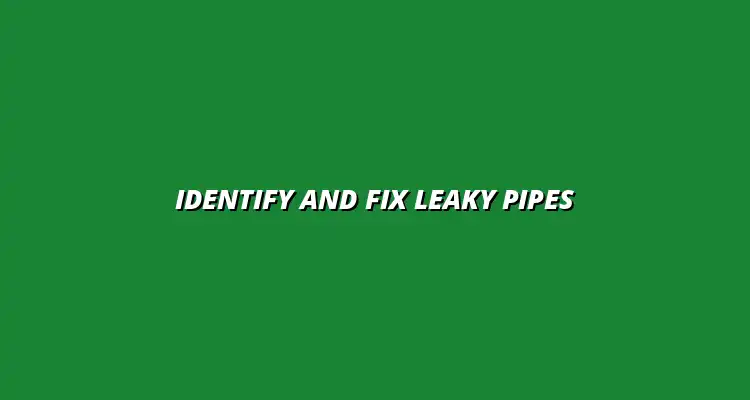
- Beginner Tips
- Dec 24
2025-01-24
Detecting and repairing leaky pipes in your home is incredibly important! Leaks can lead to significant damage and even higher bills if not addressed promptly. By understanding the impact of these leaks, you can take proactive steps to protect your home and your wallet.
When we think about leaky pipes, we often overlook how they can affect the very structure of our homes. Water from leaks can seep into walls, floors, and foundations, leading to costly repairs down the line. Plus, the longer a leak goes undetected, the more extensive the damage can become, which is why recognizing the signs early is key! Learning how to detect water leaks in your plumbing is a crucial first step.
Leaky pipes can have a ripple effect on your home. The potential for water damage is significant and can lead to a host of problems such as mold growth, which is harmful to your health. Not to mention, structural issues can arise if water continually seeps into the foundational areas of your home.
There are two main types of impacts to consider when it comes to leaky pipes: physical damage and financial strain. Let’s break those down:
Water damage is often the first thing that comes to mind when we think of leaks. It can manifest as stains on walls or ceilings, or even warped wood and peeling paint. Over time, this damage can lead to serious structural risks, as water erodes the materials meant to support your home.
To protect your home, it’s essential to stay vigilant for these signs. If you notice any unusual dampness or discoloration, it’s time to investigate further. Addressing these issues early can save you from larger headaches in the future! For example, a leaky faucet can be a simple fix; check out this guide on how to fix a leaky faucet.
Your water bill is a valuable tool for detecting leaks. If you notice an unexpected spike in usage, it could be a sign of a hidden leak. This increase often serves as a *red flag*, indicating that something may be wrong with your plumbing system.
By keeping an eye on your water bills, you can catch leaks before they spiral out of control. Regular monitoring allows homeowners to take proactive measures, ensuring that costly repairs don’t sneak up on them!
Understanding what causes pipe leaks is crucial to prevention. Many factors can contribute to these frustrating issues, and knowing them can help you safeguard your plumbing system. Here are some common culprits affecting residential properties:
As pipes age, they become less reliable. Many older homes still have the original pipes, which can be made from materials that rust or corrode easily. Regular inspections can help identify these aging systems before they cause problems.
It's essential to know the age and material of your pipes. If your home has older plumbing, consider an upgrade. This proactive step can help avoid the hassle of leaks down the road! There are many simple plumbing repairs you can tackle yourself; check out these easy plumbing repairs for homeowners.
Nature can be tough on your plumbing! Environmental factors such as extreme temperatures, soil movement, and even tree roots can wreak havoc on your pipes. For example, freezing temperatures can cause pipes to burst, while tree roots can grow into your plumbing and cause blockages or cracks.
Being aware of these environmental risks allows you to take preventive measures. For instance, insulating pipes in colder months can help protect them from freezing. Understanding how the environment affects your plumbing is key to maintaining a healthy home!
Maintaining your plumbing system is essential to avoid the hassle and expense of dealing with leaks. Regular care can prevent issues before they escalate, saving you time, money, and stress. Here are some best practices you can follow to keep your pipes in top shape!
One of the most effective ways to prevent leaks is to conduct regular inspections of your plumbing system. You might want to check for visible signs of wear, corrosion, or damage, particularly in areas like basements and under sinks. Moreover, keeping an eye on your water pressure can help you catch issues early. If you discover a leak in your kitchen sink, here's a helpful DIY guide to fixing it.
Another key aspect of pipe maintenance is insulating your pipes. Insulation helps protect against temperature changes, especially in colder climates where freezing can lead to bursts. By keeping your pipes warm, you can significantly reduce the risk of leaks.
Establishing a home maintenance schedule is a smart way to ensure you don't overlook your plumbing system. Incorporate plumbing checks into your regular home care routines so that they become a habit! This proactive approach can help you catch minor issues before they turn into major repairs.
In addition to your own inspections, consider utilizing professional services for comprehensive inspections. A plumber can provide an expert eye for potential issues you might miss. Regular professional check-ups can help maintain your plumbing system effectively. For example, if you need a plumber in Billesley, Birmingham, check out this local plumbing service.
As a homeowner, you may have questions about pipe leaks and repairs. Understanding the costs involved can help you budget effectively for any potential issues. It's also important to be aware of how insurance might cover any damages you encounter.
Estimating the costs associated with pipe repairs can vary greatly depending on the type and extent of the damage. Simple fixes may be affordable, but complex repairs could require significant investment. Here’s a look at different repair scenarios:
Insurance considerations are also important. Many homeowners' insurance policies cover certain plumbing damages, but it’s wise to review your policy to understand what is included. Contact your insurance provider for details on how they handle claims for plumbing issues. A leaky water heater pipe can be a major problem; learn how to repair a leaking water heater pipe to avoid costly repairs.
Tracking your water usage effectively is an important part of managing your water bill. By keeping an eye on your consumption, you can identify any unusual increases that might indicate a leak. Here are some handy tips for monitoring your water usage:
Implementing water-saving strategies can also help reduce your bill. Simple changes in your daily habits can lead to significant savings over time. Here are some strategies to consider. For example, learning how to fix your leaky bathroom faucet can save water and money.
Empowering yourself with knowledge about plumbing care can greatly benefit you as a homeowner. By understanding the importance of regular maintenance and knowing what signs to watch for, you can take proactive steps to protect your home from leaks.
Sharing experiences and solutions with your neighbors can build a supportive community around plumbing care. Discussing common plumbing issues and solutions can lead to better practices and help everyone avoid costly repairs. Together, we can learn from one another!
Utilizing local resources can also provide valuable plumbing help. Many towns have plumbing supply stores or local plumbers willing to share their expertise. By tapping into community knowledge, you can improve your plumbing care and strengthen neighborhood ties.
